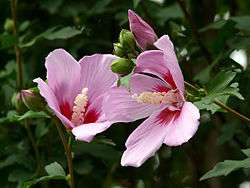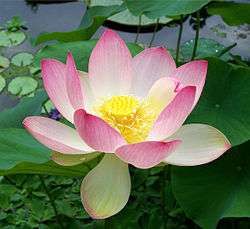蓮
See also: 莲
| ||||||||
Translingual
Han character
蓮 (radical 140, 艸+11, 14 strokes, cangjie input 廿卜十十 (TYJJ), four-corner 44304, composition ⿱艹連)
References
- KangXi: page 1052, character 16
- Dai Kanwa Jiten: character 31722
- Dae Jaweon: page 1514, character 27
- Hanyu Da Zidian: volume 5, page 3261, character 10
- Unihan data for U+84EE
Chinese
| trad. | 蓮 | |
|---|---|---|
| simp. | 莲 | |
Glyph origin
| Characters in the same phonetic series (連) (Zhengzhang, 2003) | |
|---|---|
| Old Chinese | |
| 連 | *ren |
| 漣 | *ren |
| 鰱 | *ren |
| 翴 | *ren |
| 鏈 | *ren, *rens, *r̥ʰen |
| 璉 | *renʔ |
| 僆 | *renʔ, *reːns |
| 摙 | *renʔ, *rens |
| 蓮 | *renʔ, *reːn |
| 嗹 | *reːn |
| 縺 | *reːn |
Phono-semantic compound (形聲, OC *renʔ, *reːn) : semantic 艹 + phonetic 連 (OC *ren).
Pronunciation 1
Compounds
Pronunciation 2
Definitions
蓮
- Only used in 蓮勺/莲勺.
Japanese
Etymology 1


| Kanji in this term |
|---|
| 蓮 |
| はちす Jinmeiyō |
| kun’yomi |
Originally a compound of 蜂 (hachi, “bee”) + 巣 (su, “nest, hive”), literally “beehive, honeycomb”, from the way the lotus seed resembles a honeycomb.[1][2]
Noun
蓮 (hiragana はちす, rōmaji hachisu)
- older name for hasu below: a lotus plant or flower, Nelumbo nucifera
- (Buddhism, particularly Pure Land Buddhism) a lotus bloom in the realm of Sukhāvatī (“Land of Ultimate Bliss”), as an expression of reincarnation
- alternate name for 木槿 (mukuge), Hibiscus syriacus: the rose of Sharon, rose mallow, or St. Joseph's rod
Etymology 2
| Kanji in this term |
|---|
| 蓮 |
| はす Jinmeiyō |
| kun’yomi |
/hat͡ɕisu/ → */hassu/ → /hasu/
Appears to be a contraction of hachisu above.
Usage notes
The reading hasu appears to be more common for the lotus meaning in modern Japanese.
Etymology 3
| Kanji in this term |
|---|
| 蓮 |
| れん Jinmeiyō |
| on’yomi |
From Middle Chinese 蓮 (len, “lotus fruit”). Compare modern Mandarin reading lián.
Usage notes
The ren reading is seldom used on its own. It is most often used in compounds.
Derived terms
References
- 1988, 国語大辞典(新装版) (Kokugo Dai Jiten, Revised Edition) (in Japanese), Tōkyō: Shogakukan
- 2006, 大辞林 (Daijirin), Third Edition (in Japanese), Tōkyō: Sanseidō, →ISBN
Korean
Vietnamese
Han character
蓮 (liên)
- This term needs a translation to English. Please help out and add a translation, then remove the text
{{rfdef}}.
This article is issued from
Wiktionary.
The text is licensed under Creative
Commons - Attribution - Sharealike.
Additional terms may apply for the media files.